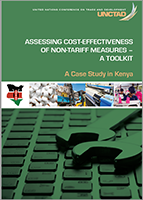
Over the years, non-tariff measures (NTMs) have become a key area of focus in trade policy, given the impact they can have on international trade, either through an impact on price, quantities traded, or both. NTMs can be technical measures or non-technical measures such as quotas and price control measures. In particular, the relevance of technical measures, including sanitary and phytosanitary (SPS) measures and technical barriers to trade (TBT) has garnered a lot significance.
Embedded in national regulations to protect consumer safety, public health and national security, these measures are generally imposed to address market failures. However, they can be costly to design, implement and comply with. As such, they affect business costs and make it difficult for traders to access international markets. When imposed on imported intermediate goods, such NTMs can indirectly affect national export competitiveness. Further, they tend to affect small and medium-sized enterprises (SMEs) disproportionately. Yet, eliminating such NTMs can have serious ramifications for the environment, public health or even national security. This makes it critical to review and streamline such NTMs to attain a balance between costs and benefits, through adoption of good regulatory practices in NTMs design, implementation and compliance.
The Non-tariff Measures Cost Effectiveness Toolkit is designed to provide a framework to undertake such a review. Specifically, the toolkit focuses on reviewing NTMs applicable to imported intermediate inputs relevant to a strategic national value chain. It aims to encourage good regulatory practices and support the design and implementation of quality regulations that achieve public policy objectives at as-low-as-possible compliance costs.
It is designed to provide governments and policymakers a framework in the form of a step-by-step deployment guide, including the tools needed for such an evaluation. These include a sample survey, in-depth interview guidelines, guidelines for focus group discussions, a detailed cost assessment spreadsheet, potential approaches for analyzing stakeholder input, and ways of generating suitable policy options. Built on three pillars – Design, Implementation and Compliance, findings from the toolkit should enable users to generate policy options towards implementing well-designed NTMs that meet economic and non-economic policy objectives.
This study shows the deployment of the toolkit in the Kenyan cotton, textiles and apparel (CTA) value chain. Following the step-by-step approach of the toolkit, this case study covers:
- Toolkit Step 1: Product selection and NTM mapping
- Toolkit Step 2: Stakeholder Identification
- Toolkit Step 3 & 4: Stakeholder Engagement and Input Analysis: Key Findings
- Toolkit Step 5: Policy Options
For each of the six policy options, the study also proposes “a way forward” for implementation, covering a list of potential national and international development partners who can help push forward the agenda through political and technical support, thus easing private sector burden, strengthening regional value chain (RVC) and enhancing Kenya’s export competitiveness In the CTA sector – all through the adoption of good regulatory practices.




